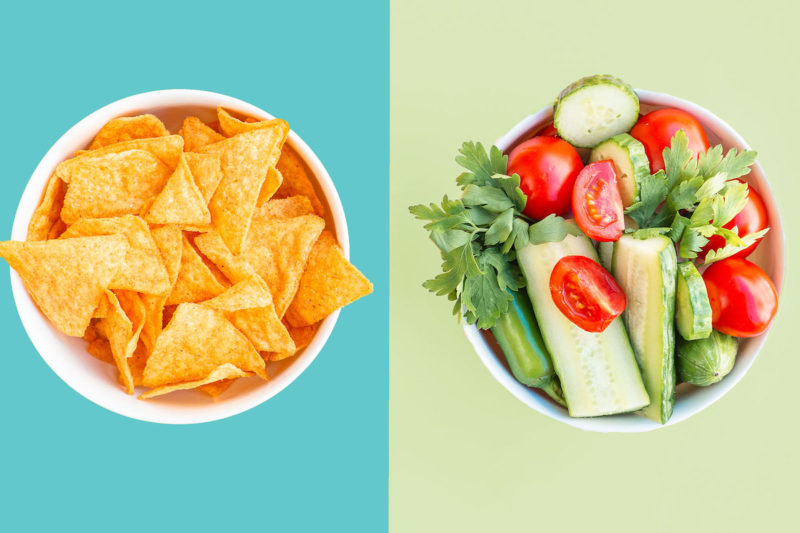In this regular column, we look at three recent studies related to metabolic health, highlight the key findings and offer our perspective. This month, research on the role processed food plays in obesity and metabolic dysfunction.
Carbs—not calories—are driving the obesity epidemic
The Study: The carbohydrate-insulin model: a physiological perspective on the obesity pandemic
What it Says: The comprehensive paper seeks to be the final nail in the coffin of the long-held view that the obesity epidemic is driven by people eating too much and moving too little. If it’s hard to believe that that view is wrong, it’s because it has been central to how we talk about weight loss for decades, despite growing evidence that it is overly simplistic and does not explain why obesity has only increased or why calorie restriction diets so rarely work.
That Energy Balance Model (EBM) seems to make intuitive sense: we gain weight because we consume more calories than we burn. However, as the authors note in the abstract, “Conceptualizing obesity as a disorder of energy balance restates a principle of physics without considering the biological mechanisms that promote weight gain.”
“Doctors and policymakers need to stop emphasizing total calorie intake and talk more about what people are eating, not how much.”
Instead, in the Carbohydrate Insulin Model (CIM), they offer as an alternative, the types of food we eat—particularly excessive carbohydrates (including added sugars and refined grains)—change our hormonal balance in a way that makes our body store more fat, and that makes us obese.
The basic mechanism goes like this: When we eat high glycemic foods, the excess glucose triggers a flood of insulin, the hormone charged with shuttling excess glucose into cells for energy or storage. That insulin (and related actions) are still at work—preventing fat burning and storing glucose—even when most of the glucose has been dealt with, which can drive glucose levels too low (the familiar blood sugar crash after a spike). This perceived energy deficit drives the body to continue to try to preserve energy—i.e., build fat—and may even increase appetite and cravings for more carbohydrate-laden foods.
The CIM also provides a framework to evaluate the role of other dietary inputs that appear to affect weight gain, such as fructose consumption (which can drive the liver to create fatty acids and drive liver insulin resistance), the role of fiber on metabolism, and things like food order and timing.
The paper also lists several testable hypotheses that arise from this model, including various ways in which glycemic load and insulin affect fat creation and storage in different tissue, and cite dozens of studies demonstrating these mechanisms at work.
Anticipating the skepticism that will arise from declaring the dominant model wrong, the paper walks through common criticisms of CIM and knocks them down one by one.
Finally, the authors share the clinical and public health implications of this new way of seeing obesity. In short, doctors and policymakers need to stop emphasizing total calorie intake and talk more about what people are eating, not how much.
Levels Take: This seminal paper features 18 co-authors, including lead author Harvard Medical School Professor of Pediatrics Dr. David Ludwig, renowned Cornell cell biologist Lewis Cantley, and science journalist Gary Taubes. That impressive roster matters because the importance of this paper isn’t that the CIM is new, but that the paper is definitive about its role.
To reverse the metabolic health crisis—in which obesity plays a starring role—individuals changing behavior is not enough; we need a societal shift in how we talk about food and its relationship to health. That’s what drives policy reform (such as ending subsidies of unhealthy foods or promoting unhealthy dietary guidelines) and industry reform (such as reducing added sugar in products). In the same way that fats were (unfairly) demonized for decades, leading to an entire low-fat category of food, we’re hopeful that research like this will drive a conception of a healthy diet as one that significantly minimizes refined sugars and carbohydrates.

Understanding blood sugar and weight loss: why tracking glucose with a continuous glucose monitor (CGM) may be more insightful than tracking calories
Real-time continuous glucose monitoring (CGM) looks deeper than simple calorie models to help us understand weight loss.
Read the Article
How calorie-counters can eat for better metabolic health
Calorie counting alone rarely leads to sustained weight loss. Here’s why type of calories matters more, and how stable blood sugar can help keep those pounds off.
Read the ArticleUltra-processed Food Consumption is Still Rising
The Study: Ultra-processed food consumption among US adults from 2001 to 2018
What it Says: The best source we have for population-wide data about eating trends is the CDC’s bi-annual National Health and Nutrition Examination Survey (NHANES), which combines a questionnaire and a physical examination for about 5,000 people meant to be representative of the population. This paper looked at data from nine NHANEs surveys from 2001 to 2018 to study trends in consumption of four different types of processed foods:
- Ultra-processed: Foods with additives or few whole food ingredients; includes most packaged snacks, frozen meals, granola bars, soda, and cereal.
- Processed foods: “Foods such as canned fish, vegetables and artisanal cheeses, which are manufactured by adding salt, sugar, oil, or other processed culinary ingredients to minimally processed foods.”
- Processed culinary ingredients: Table sugar, oils, fats, and salt.
- Minimally processed foods: Frozen fruit or vegetables, breads with just a few ingredients, milk, canned beans.
First, the bad news: Consumption of ultra-processed foods increased from 53.5% of our average daily calorie intake in 2001 to 57% in 2018. Among specific foods, we saw increases in desserts like cookies and cakes, frozen meals (including pizzas), and ultra-processed fish and meat.
The good news: There were decreases in soda and other sugar-sweetened beverages and refined grain products like cereal and bread. Overall, sugar consumption has also decreased.
Consumption of minimally processed foods decreased by about the same percentage, mostly from less meat and dairy. The other two categories stayed relatively steady.
Among the notable demographic trends: adults over 60 ate more ultra-processed foods than other age groups, while Hispanics and college-educated adults consumed the least.
Levels Take: As Levels advisor Dr. Robert Lustig often says, “It’s not what’s in the food that matters, it’s what’s been done to the food.” Avoiding processed foods is one of the critical points of the Levels dietary philosophy, whether you’re vegan or paleo.
It’s disheartening to see any increase in the consumption of ultra-processed foods, but the categorizations here are essential. That group includes things most people consider “healthy,” such as energy bars and drinks as well as meat substitutes, so the fact that people are eating more of those may reflect at least a growing desire to eat healthier, even if those foods leave a lot to be desired. Also, the decrease in sugar-sweetened beverages, while not universal across demographics, is another positive sign.
Still, the reality is that we have a long way to go in eliminating ultra-processed foods from most people’s diets, but we know that doing so is vital to reversing the metabolic health crisis.

What are processed foods and why are they so bad for metabolic health?
Here’s what “processed” actually means, how these foods impact your metabolic health, and how to avoid the worst of them in the grocery aisles
Read the Article
How processed food is harming kids’ brains and bodies
In this excerpt from his latest book, Metabolical, Dr. Robert Lustig discusses the true impact of our kids' high-sugar, low-nutrient diet.
Read the ArticleReducing Processed Food Intake Could Save Half a Million Lives and $160b
What it Says: The National Salt and Sugar Reduction Initiative (NSSRI) is a consortium of more than 100 local, state, and federal health departments initiated by the New York City Health Department to set voluntary industry targets for reducing sugar and salt in 15 categories of processed foods. The effort was modeled after a similar program in the UK.
The group released its final recommendations in February 2021. In general, it called for a 20% sugar reduction in most categories and 40% in sugar-sweetened beverages (from 8.9g per 100ml in 2018 to 5.6g in 2026).
This study sought to analyze the potential impact of these recommendations on overall health and healthcare spending. Researchers based their model on NHANES data and created a simulation population of 1 million people who they followed to age 100 or death, looking at 10-year and lifetime outcomes. They assumed a gradual 8-year adoption of the changes.
They found that the changes would prevent nearly half a million cardiovascular deaths and three-quarters of a million cases of diabetes over a lifetime (a mean of 28 years in the simulated population). They estimated the effort would cost the industry around $23b but would save around $120b in healthcare costs, $160b if they included factors like productivity and informal care. And they found the results scaled: even if the industry only achieved 50% compliance, we’d still achieve 50% of the benefits.
Levels Take: Although there are many limitations to this kind of study—NHANES data is self-reported, models make many assumptions—the numbers involved are at a scale that’s worth paying attention to. Trying to achieve society- or industry-wide change can feel like an impossible task, so it’s encouraging to see that even relatively modest reductions in sugar—not eliminating it, just reducing it 20%—could have a meaningful impact on hundreds of thousands of people. It’s important to remember that 659,000 people die from heart disease each year, and the risk of dying from heart disease is directly related to how much added sugar is consumed. And, about 270,700 people in the US per year have diabetes listed as an underlying or contributing cause of death. These numbers are monumental. This study likely underestimates the positive impact of sugar reduction on early mortality and healthcare costs. Still, it is an excellent step in the right direction in highlighting the importance of public health efforts to minimize added sugar.

Why have dietary guidelines been so wrong, and how do they still need to change?
Official dietary guidelines play a significant role in setting policy and habits. Here’s why they once demonized fat in favor of carbs and why they still recommend added sugar.
Read the Article





